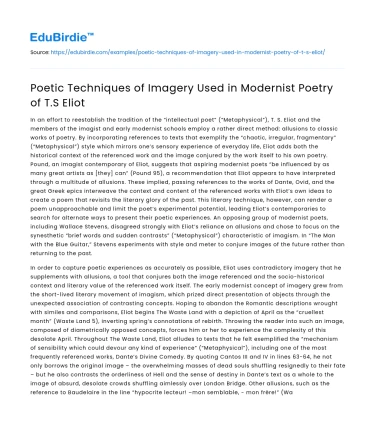In an effort to reestablish the tradition of the “intellectual poet” (“Metaphysical”), T. S. Eliot and the members of the imagist and early modernist schools employ a rather direct method: allusions to classic works of poetry. By incorporating references to texts that exemplify the “chaotic, irregular, fragmentary” (“Metaphysical”) style which mirrors one’s sensory experience of everyday life, Eliot adds both the historical context of the referenced work and the image conjured by the work itself to his own poetry. Pound, an imagist contemporary of Eliot, suggests that aspiring modernist poets “be influenced by as many great artists as [they] can” (Pound 95), a recommendation that Eliot appears to have interpreted through a multitude of allusions. These implied, passing references to the works of Dante, Ovid, and the great Greek epics interweave the context and content of the referenced works with Eliot’s own ideas to create a poem that revisits the literary glory of the past. This literary technique, however, can render a poem unapproachable and limit the poet’s experimental potential, leading Eliot’s contemporaries to search for alternate ways to present their poetic experiences. An opposing group of modernist poets, including Wallace Stevens, disagreed strongly with Eliot’s reliance on allusions and chose to focus on the synesthetic “brief words and sudden contrasts” (“Metaphysical”) characteristic of imagism. In “The Man with the Blue Guitar,” Stevens experiments with style and meter to conjure images of the future rather than returning to the past.
In order to capture poetic experiences as accurately as possible, Eliot uses contradictory imagery that he supplements with allusions, a tool that conjures both the image referenced and the socio-historical context and literary value of the referenced work itself. The early modernist concept of imagery grew from the short-lived literary movement of imagism, which prized direct presentation of objects through the unexpected association of contrasting concepts. Hoping to abandon the Romantic descriptions wrought with similes and comparisons, Eliot begins The Waste Land with a depiction of April as the “cruellest month” (Waste Land 5), inverting spring’s connotations of rebirth. Throwing the reader into such an image, composed of diametrically opposed concepts, forces him or her to experience the complexity of this desolate April. Throughout The Waste Land, Eliot alludes to texts that he felt exemplified the “mechanism of sensibility which could devour any kind of experience” (“Metaphysical”), including one of the most frequently referenced works, Dante’s Divine Comedy. By quoting Cantos III and IV in lines 63-64, he not only borrows the original image – the overwhelming masses of dead souls shuffling resignedly to their fate – but he also contrasts the orderliness of Hell and the sense of destiny in Dante’s text as a whole to the image of absurd, desolate crowds shuffling aimlessly over London Bridge. Other allusions, such as the reference to Baudelaire in the line “hypocrite lecteur! –mon semblable, - mon frère!” (Waste Land 7) serve a less literal purpose, and are employed primarily for the context surrounding them. The actual meaning of the line does not add much to the poem, but the source – Baudelaire’s Les Fleurs du Mal, a scandalous collection of poetry that criticized the heavy industrialization and listless human spirit through decadent, symbolist imagery – contributes its themes to Eliot’s poem without directly voicing them. Eliot compares this effect to Keats’s use of a nightingale as the central subject of his Ode: the bird “contains a number of feelings which have nothing particular to do with the nightingale, but which the nightingale … served to bring together” (“Tradition”). In addition, these allusions serve to place Eliot’s poem within the context of literary history by forcing the reader to recall the works of Ovid and Aenid when experiencing The Waste Land. According to Eliot, a poem does not become a part of literary history simply by being written, but must actively recall the classic works of the past to gain entrance; “it cannot be inherited, and if you want it you must obtain it by great labor” (“Tradition”) from the poet through heavy allusion.
Save your time!
We can take care of your essay
- Proper editing and formatting
- Free revision, title page, and bibliography
- Flexible prices and money-back guarantee






 Stuck on your essay?
Stuck on your essay?

